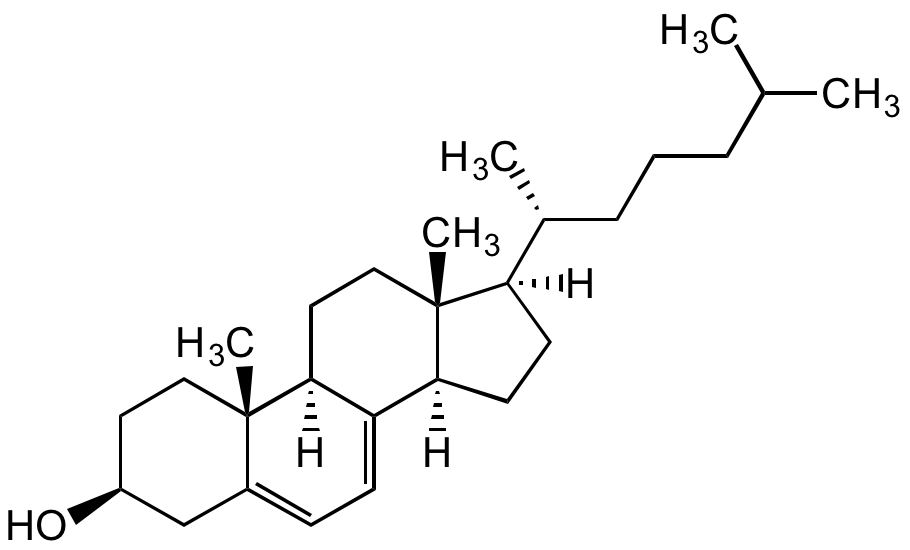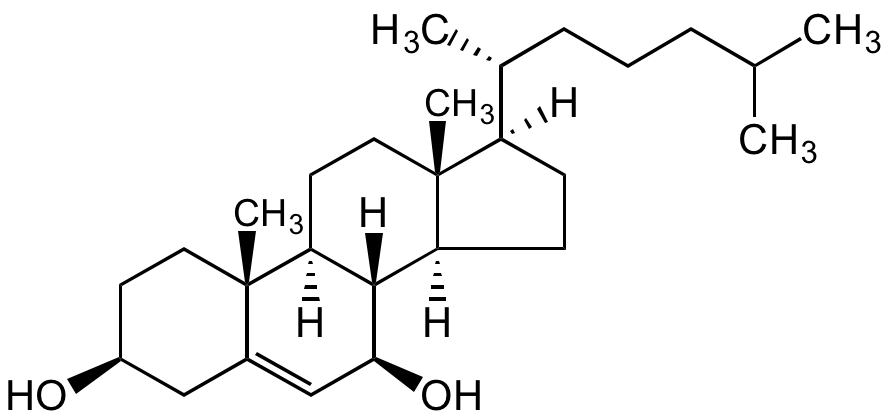
Chemical Structure
7-Dehydrocholesterol
CDX-D0331
CAS Number434-16-2
Product group Chemicals
Estimated Purity>95%
Molecular Weight384.64
Overview
- SupplierChemodex
- Product Name7-Dehydrocholesterol
- Delivery Days Customer10
- CAS Number434-16-2
- CertificationResearch Use Only
- Estimated Purity>95%
- Molecular FormulaC27H44O
- Molecular Weight384.64
- Scientific DescriptionChemical. CAS: 434-16-2. Formula: C27H44O. MW: 384.64. Synthetic Precursor of cholesterol and vitamin D3. It is reduced to cholesterol by the enzyme 3beta-hydroxysterol-Delta7-reductase (DHCR7) in the last step of cholesterol biosynthesis. Mutations in the gene encoding DHCR7 lead to increased levels of 7-DHC and the neurodevelopmental syndrome Smith-Lemli-Opitz syndrome (SLOS). 7-DHC is used as a biomarker for SLOS screenings. Inhibits human fibroblast sphingomyelinase. Shown to have cytotoxic effects on melanoma cells. In skin, photolysis of 7-DHC by ultraviolet light produces vitamin D3. UV/Vis: lambdamax 271, 282, 293nm. - Precursor of cholesterol and vitamin D3. It is reduced to cholesterol by the enzyme 3beta-hydroxysterol-Delta7-reductase (DHCR7) in the last step of cholesterol biosynthesis. Mutations in the gene encoding DHCR7 lead to increased levels of 7-DHC and the neurodevelopmental syndrome Smith-Lemli-Opitz syndrome (SLOS). 7-DHC is used as a biomarker for SLOS screenings. Inhibits human fibroblast sphingomyelinase. Shown to have cytotoxic effects on melanoma cells. In skin, photolysis of 7-DHC by ultraviolet light produces vitamin D3. UV/Vis: lambdamax 271, 282, 293nm.
- SMILES[H][C@@]1(CC[C@@]2([H])C3=CC=C4C[C@@H](O)CC[C@]4(C)[C@@]3([H])CC[C@]12C)[C@H](C)CCCC(C)C
- Storage Instruction-20°C,2°C to 8°C
- UNSPSC12352200


![7-Dehydrocholesterol [434-16-2]](https://www.targetmol.com/group3/M00/37/F7/CgoaEWayVIuETYOQAAAAAIjeXeg516.png)
